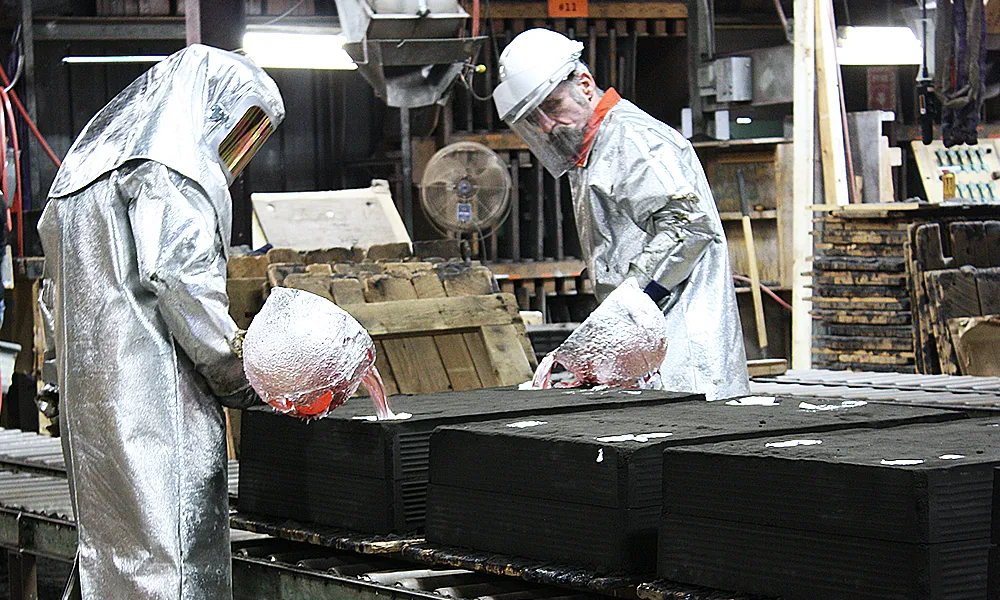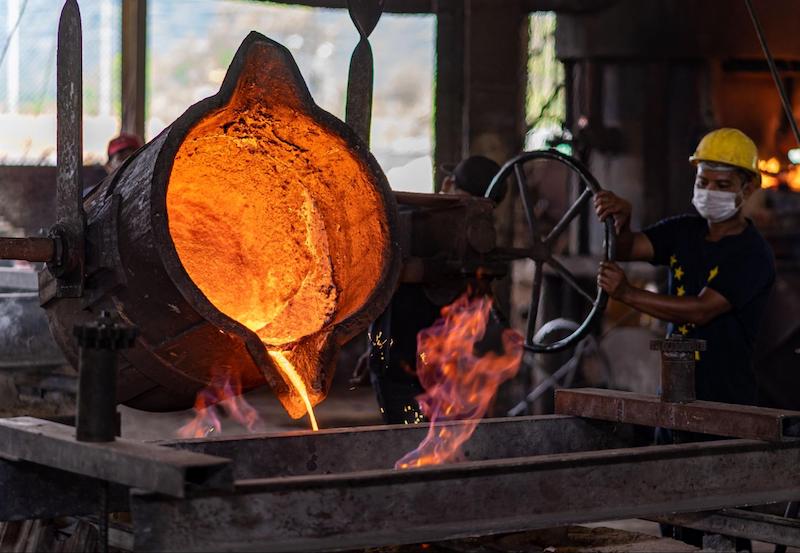The next era of Aluminum Foundry in green engineering
Wiki Article
The Benefits of Making Use Of Aluminum Shop for High-Quality Steel Casting Solutions
Aluminum foundries offer distinct advantages for top notch steel spreading remedies. Their light-weight properties contribute to structural integrity while enhancing fuel efficiency across various applications. Additionally, aluminum's extraordinary corrosion resistance guarantees sturdiness, decreasing lasting upkeep expenses. This versatility permits complex layouts in numerous markets. Aluminum Foundry. The benefits prolong beyond these characteristics, hinting at a broader influence on producing processes and sustainability. What various other variables make aluminum a significantly preferred option in today's market?Lightweight Residences of Aluminum Alloys
Aluminum alloys are renowned for their light-weight buildings, making them a favored selection in different markets, including aerospace and vehicle. The density of aluminum is around one-third that of steel, enabling significant weight decreases without compromising structural stability. This feature makes it possible for makers to generate components that enhance fuel performance and general efficiency in lorries and airplane.The use of aluminum alloys contributes to reduce transportation prices due to decreased weight, which is specifically advantageous in shipping and logistics. Designers and developers utilize these materials to develop complex shapes and styles that would certainly be impractical with much heavier steels. The capacity to combine light-weight characteristics with strength and toughness makes aluminum alloys a perfect choice for applications calling for rigorous performance standards. Generally, the light-weight nature of aluminum alloys positions them as an important product in progressing innovation and enhancing sustainability throughout numerous industries.
Phenomenal Corrosion Resistance
When exposed to severe atmospheres, materials commonly surrender to destruction; nonetheless, aluminum alloys exhibit extraordinary rust resistance that establishes them apart. This exceptional property stems from a natural oxide layer that forms on the surface area of light weight aluminum, giving a safety obstacle versus wetness, salt, and other harsh representatives. Unlike several steels, light weight aluminum does not corrosion, which makes it a suitable selection for applications in aquatic, automobile, and building industries.Additionally, light weight aluminum alloys can be treated with different finishes and surfaces to improve their corrosion resistance better. These therapies guarantee longevity and longevity, lowering maintenance costs over time. The capacity to stand up to corrosive problems without considerable wear and tear allows makers to count on aluminum elements for prolonged periods, inevitably resulting in greater functional efficiency. Subsequently, the extraordinary corrosion resistance of light weight aluminum alloys positions them as a remarkable option for high-quality steel casting options in diverse atmospheres.
Superior Strength-to-Weight Ratio

Moreover, the strength-to-weight proportion of aluminum alloys is especially beneficial in applications where weight savings is crucial. For circumstances, in aerospace design, lighter elements add to boosted gas effectiveness and performance. The combination of toughness and minimized mass likewise facilitates less complicated handling and setting up during making procedures. Consequently, light weight aluminum foundries play a crucial function in producing high-quality spreadings that leverage these homes, ensuring that sectors can meet the needs of contemporary design obstacles efficiently.
Versatility in Applications
Aluminum foundries show remarkable flexibility throughout various markets, suiting a variety of applications. Their ability to personalize remedies assurances that particular demands are met, improving functionality and effectiveness. This flexibility makes aluminum casting a favored option in fields such as automobile, aerospace, and durable goods.Varied Industry Applications
Flexibility specifies the role of aluminum foundries in different markets, showcasing their capacity to adjust to a multitude of applications. These foundries serve industries such as vehicle, aerospace, and durable goods, showing their extensive abilities. In the auto field, light weight aluminum spreadings add to light-weight designs, enhancing fuel efficiency and performance. Aerospace applications gain from the strength-to-weight ratio of aluminum, important for aircraft components. Additionally, consumer products, consisting of electronic devices and devices, utilize aluminum's toughness and visual charm. The factory's capacity to produce intricate forms and intricate layouts satisfies the distinct demands of each market, making certain high-quality solutions. This adaptability not only improves manufacturing efficiency but also promotes development across varied market sectors, solidifying light weight aluminum's duty as a favored material.Modification for Specific Demands
Customizing aluminum spreadings to fulfill particular customer needs exemplifies the flexibility of foundries in resolving special sector obstacles. Foundries can develop personalized designs that deal with various requirements, making sure perfect efficiency for diverse applications. This flexibility enables for the manufacturing of components with distinct shapes, sizes, and weights, boosting their performance in specific atmospheres. Progressed spreading methods make it possible for the incorporation of specialized alloys, which can enhance buildings such as stamina, deterioration resistance, and thermal conductivity. By collaborating carefully with customers, light weight aluminum foundries can determine exact demands and deliver tailored options that straighten with task goals. This commitment to personalization not just fosters advancement yet additionally positions aluminum castings as a favored selection across several markets.Boosted Manufacturing Efficiency
Enhanced production effectiveness in light weight aluminum foundries is attained with structured production procedures that maximize operations. By implementing these processes, foundries can significantly minimize preparations, enabling for quicker turn-around on jobs. In addition, economical manufacturing approaches better boost total performance, adding to boosted competition in the marketplace.Structured Production Processes
Enhancing production procedures is crucial for attaining boosted manufacturing effectiveness in aluminum foundries. By optimizing workflows, light weight aluminum foundries can decrease waste and minimize operational costs. Automated systems play a pivotal role, allowing for specific control over spreading specifications and guaranteeing consistent top quality. Furthermore, the combination of advanced modern technologies, such as computer-aided style (CAD) and simulation software program, assists in much better planning and source allotment. This not only increases the design-to-production cycle however also boosts the capability to adjust to altering market demands. Additionally, staff member training and development add to an extra experienced workforce, qualified of running innovative machinery. Ultimately, these streamlined procedures result in better outcome, permitting aluminum foundries to fulfill customer assumptions while maintaining competitive rates.Decreased Lead Times
Achieving minimized preparations is a direct benefit of applying streamlined production procedures in aluminum foundries. By enhancing operations and reducing traffic jams, these foundries enhance manufacturing performance, permitting quicker turn-around on tasks. Aluminum Foundry Automation technologies and accurate organizing further contribute to this effectiveness, making it possible for manufacturers to react rapidly to client needs. The capacity to produce premium spreadings in much shorter durations not only satisfies client expectations however also enhances affordable placing in the marketplace. Additionally, reduced lead times help with much better stock monitoring, as organizations can readjust their supply chains with better agility. Essentially, light weight aluminum foundries that focus on minimized preparations can use premium solution while keeping the top quality criteria crucial for costs steel spreading remedies.Cost-efficient Manufacturing Approaches

Economical Production Processes
Many aluminum foundries are progressively taking on cost-effective production processes to enhance efficiency while lessening expenditures. These procedures frequently integrate sophisticated modern technologies such as automation and accuracy spreading, which streamline operations and decrease labor prices. By making use of computer-aided design (CAD) and computer numerical control (CNC) machinery, foundries can achieve higher accuracy and decrease material waste, resulting in much more effective production cycles.In addition, using lean manufacturing principles allows foundries to maximize their operations, get rid of bottlenecks, and improve total effectiveness. This focus on continuous renovation not just reduces manufacturing costs but additionally improves product top quality.
In addition, calculated sourcing of resources can further add to cost financial savings, making certain that foundries preserve affordable prices without compromising on top quality. In general, these cost-effective production processes position aluminum foundries to meet expanding market needs while maintaining success and sustainability in the metal spreading industry.
Eco-Friendly and Recyclable Material
Aluminum foundries are progressively recognizing the importance of environment-friendly and recyclable materials in their production processes. Aluminum itself is one of one of the most recyclable metals, with the capacity to be reused forever without shedding its buildings. This particular considerably reduces the environmental footprint connected with steel spreading, as recycled light weight aluminum needs only a fraction of the power needed to produce brand-new light weight aluminum from bauxite ore.Making use of recycled light weight aluminum not just minimizes waste but likewise conserves natural sources and minimizes greenhouse gas emissions. As industries change towards lasting techniques, aluminum foundries are adopting a lot more eco-conscious approaches, such as making use of energy-efficient technologies and decreasing dangerous exhausts during manufacturing.
Regularly Asked Questions
What Kinds Of Aluminum Alloys Are Typically Utilized in Factory Processes?
Frequently utilized light weight aluminum alloys in factory procedures consist of A356, A380, and A413 (Aluminum Foundry). These alloys are preferred for their exceptional castability, mechanical buildings, and deterioration resistance, making them appropriate for numerous commercial applications and partsJust How Does Aluminum Casting Contrast to Various Other Metal Casting Techniques?
Aluminum casting offers advantages such as lighter weight, excellent deterioration resistance, and excellent thermal conductivity contrasted to various other steel spreading techniques. Furthermore, it offers superior surface area coating and accuracy, making it a favored choice for many applications.What Industries Advantage A Lot Of From Aluminum Factory Services?
Various markets, including automotive, aerospace, electronic devices, and building and construction, substantially gain from aluminum shop solutions. These industries leverage light weight aluminum's lightweight, corrosion-resistant residential or commercial properties and versatility, making certain high-performance components and cost-efficient production solutions for varied applications.Exactly how Does the Recycling Refine for Aluminum Job?
The recycling procedure for aluminum entails gathering scrap, shredding it, thawing it down, and eliminating impurities. This recycled light weight aluminum can then be cast right into brand-new products, significantly decreasing energy consumption and ecological impact contrasted to primary manufacturing.
What Are the Normal Lead Times for Aluminum Casting Projects?
Lead times for aluminum casting jobs normally vary from a few weeks to a number of months, depending on elements such as task complexity, mold preparation, and manufacturing quantity, which collectively influence the general timeline for conclusion.Report this wiki page